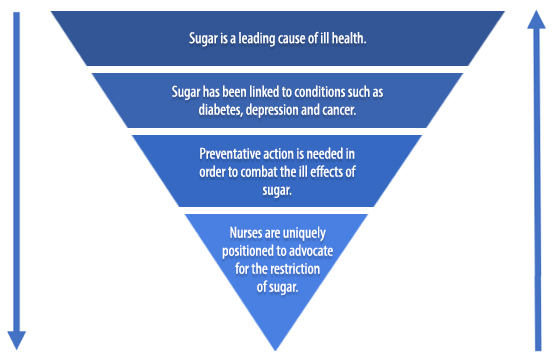75 Patterns of Organization and Methods of Development
Patterns of organization can help readers follow the ideas within your writing and also work as methods of development to help you recognize and further develop ideas and relationships in your writing.
General to specific or specific to general
It might be useful to organize your topic like a triangle. In Figure 7.5, the arrow on the left side of the triangle represents starting with the most general, big-picture information first, and then later moving to more detailed and more personal information. The arrow on the right side of the triangle represents starting with the specific information first and then moving to the more global, big-picture stuff. The triangle is a general guide, and you can move around within it. For example, each paragraph might be its own triangle, starting with the general or specific and moving out or in. However, if you begin your paper very broadly, it might be effective to end it in a more specific, personal way. If you begin your paper with a personal story, consider ending by touching on the global impact and importance of your topic.
Figure 7.5: Organizing topic like a triangle
Other ways to organize ideas
Instead of organizing ideas based on whether they are broad or specific, you could organize them using one of the following ways:
- Chronological order (the order in time that events take place).
- Compare and contrast (ideas are organized together because of their relationship to each other).
- Most important information first (consider what you want readers to focus on first).
Note that order of importance is a particularly good choice when you are trying to persuade and convince the reader. Most papers move from the least to the most important point, and the paragraphs are arranged in an effort to build the essay’s strength. Sometimes, however, it is necessary to begin with your most important supporting point, such as in an essay that contains a thesis that is highly debatable or when writing persuasively.
Attribution statement
Content from this page was remixed with our own original content, and adapted, with editorial and organizational changes, from:
The Word on College Reading and Writing by Carol Burnell, Jaime Wood, Monique Babin, Susan Pesznecker, and Nicole Rosevear, licensed under a Creative Commons Attribution-NonCommercial 4.0 International License, except where otherwise noted.Download for free at: https://openoregon.pressbooks.pub/wrd/
Content from the last paragraph was adapted from:
Writing for Success 1st Canadian Edition by Tara Horkoff is licensed under a Creative Commons Attribution-NonCommercial-ShareAlike 4.0 International License, except where otherwise noted. Download for free at: https://opentextbc.ca/writingforsuccess/


